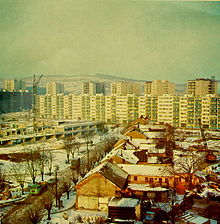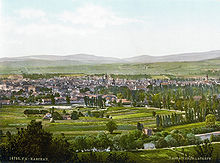Košice
![]()
The title of this article is ambiguous. For other meanings, see Košice (disambiguation).
Košice ([ˈkɔʃɪʦɛ]![]() , German Kaschau, Hungarian Kassa, Romani Kascha, neo-Latin Cassovia) is a city on the Hornád River in eastern Slovakia near the border with Hungary. With its 238,138 inhabitants (as of 31 December 2020), it is the second largest city in the country after Bratislava.
, German Kaschau, Hungarian Kassa, Romani Kascha, neo-Latin Cassovia) is a city on the Hornád River in eastern Slovakia near the border with Hungary. With its 238,138 inhabitants (as of 31 December 2020), it is the second largest city in the country after Bratislava.
Košice is the central city of Eastern Slovakia and the seat of the Košický kraj. The city is divided into four administrative districts (okresy). The town is the seat of the Greek Catholic and Protestant Reformed bishops. Since 1995 it has also been the seat of the Roman Catholic archbishopric. Košice is also a university town, the seat of the Constitutional Court and a centre of the Roma ethnic group in Slovakia.

Košice and surroundings on a satellite photo
Geography
Location
Košice is situated in the Košická kotlina on the Hornád River, in the eastern foothills of the Slovak Ore Mountains, near the Čierna hora (northwest) and Volovské vrchy (southwest) mountain ranges; the Torysa River flows along the eastern border of the city, and the kotlina is bordered to the east by the Slanské vrchy mountain formation. Other significant watercourses are the Čermeľský potok and the Myslava as right-bank tributaries of Hornád, and the Ida in the Šaca district. The town is connected by a series of municipalities with the third largest town Prešov (36 km to the north) and is located about 400 km east of the capital Bratislava. The borders with Hungary, Ukraine and Poland are 20, 80 and 90 km away respectively. The area of the town covers 242.77 km²; the highest point is in the northwest on the hill Vysoký vrch (literally "High Hill", 851 m a.s.l. ), the lowest point is in the southeast at 184 m a.s.l.. The town centre is situated at 208 m a.s.l.
Košice borders the following municipalities: Kostoľany nad Hornádom and Družstevná pri Hornáde to the north, Budimír and Beniakovce to the northeast, Hrašovík, Košické Oľšany, Sady nad Torysou and Košická Polianka to the east, Vyšná Hutka, Nižná Hutka, Nižná Myšľa and Kokšov-Bakša to the southeast, Valaliky, Haniska and Sokoľany in the south, Bočiar, Seňa, Veľká Ida, Šemša and Malá Ida in the southwest, Baška and Nižný Klátov in the west and Vyšný Klátov, Košická Belá, Veľká Lodina and Sokoľ in the northwest.
Climate
Košice is located in the temperate zone and in the area of continental climate with four distinct seasons. Summers are usually warm and dry, winters cold and humid.
| Košice | ||||||||||||||||||||||||||||||||||||||||||||||||
| Climate diagram | ||||||||||||||||||||||||||||||||||||||||||||||||
| ||||||||||||||||||||||||||||||||||||||||||||||||
| Monthly average temperatures and precipitation for Košice
Source: Weather Information for Kosice. Slovak Hydrometeorological Institute (SHMÚ). | ||||||||||||||||||||||||||||||||||||||||||||||||||||||||||||||||||||||||||||||||||||||||||||||||||||||||||||||||||||||||||||||||||||||||||||||||||||||||||||||||||||||||||||||||||||||||||||||||

Panorama from the southeast; old town with Elisabeth Cathedral on the right
History
Origin
The area is an old settlement area (Neolithic, Bronze Age). In the 7th century Avars settled, Slavic findings date from the 8th century. In the 9th century the town was part of the Neutra principality and then of Great Moravia.
Towards the end of the 11th century the town was incorporated into the Kingdom of Hungary. The settlement core of today's Košice was formed by a Slavic settlement in today's Kováčska Street. Parallel to this old settlement, whose exact date of origin is unknown, German colonists founded a trading settlement in the neighbourhood at the beginning of the 13th century. Still in the 13th century, the two settlements merged, and the Slavic-German settlement thus created received its first city rights around 1248, as one of the first cities in the kingdom. Shortly before, in 1230, there was the first written mention of the town (as villa Cassa).
Kashov in the Kingdom of Hungary
In the following centuries Kashov was one of the most important and largest cities of the Kingdom of Hungary. Due to its location on a trade route to Poland and various privileges, trade flourished and its importance grew. The first guild rules have been handed down from 1307. After the defeat of the Aba family by the troops of Charles I in the battle of Rozhanovce in 1312, several rights were borrowed from the town as a reward. In 1347 Kashov became the second royal free town in the Kingdom of Hungary after the capital Buda. In 1369 the town was granted its coat of arms by King Louis the Great. This was the first sovereign granting of a coat of arms to a legal entity in Europe. Until then, this privilege had only existed for natural persons. In the 14th and 15th centuries the development of the town reached its peak. In the 15th century, the town played an important role in the Pentapolitana - a union of five towns in present-day eastern Slovakia - Košice, Prešov, Bardejov, Sabinov and Levoča. In the middle of the 15th century it came under the rule of John Giskra (Jan Jiskra). However, it remained one of the most important and largest centres in the 16th and 17th centuries.
In the 16th century the town was affected by the wars between Ferdinand I and John Zápolya. In the 17th and 18th centuries Kashov was the residence of Francis II Rákóczi (Hungarian Rákóczi Ferenc, Slovak František Rákoci). It was here that the anti-Habsburg uprisings flared up most violently. In 1670 the Habsburgs had a fortress built. In the 1670s Kashov was besieged several times by Kurucs. In 1682 the city was conquered by Imre Thököly, who lost it again in 1685. The fortress was destroyed in 1713. In the 17th century, Kashov was the de facto capital of Upper Hungary, which was then the name for what is now eastern Slovakia and parts of what is now northeastern Hungary - and thus the northern half of what was then Hungary. From 1563 to 1686 the town was the seat of the "Capitanate of Upper Hungary" and from 1567 to 1848 the seat of the Spiš Chamber, a branch of the supreme financial authority in Vienna for Upper Hungary.
At the beginning of the 18th century, the Ottomans were repelled and the importance of the city diminished as new trade routes passed by the city. The rich medieval town subsequently developed into an agricultural provincial town. The city walls were mostly demolished in the 18th century. In 1802 a bishopric was founded. The first factories were built in the 1840s. The town's environs were the scene of several battles during the revolutions of 1848-49. The Hungarian army captured the town on February 15, 1849, but it was repulsed by Russian intervention troops on June 24, 1849. The first railway line was built from Miskolc in 1860. Shortly after, the lines to Chop, Prešov and Žilina followed.
World Wars
After the disintegration of Austria-Hungary, Kaschau fell to Czechoslovakia on 29 December 1918 and was briefly the seat of the "Slovak Councillor Republic" in the summer of 1919. Czechoslovak rule was confirmed by the Treaty of Trianon. After the First Vienna Arbitration, Kaschau again belonged to Hungary from 1938 to 1945.
During the extermination of the Jews from Hungary, the station was a border station. Important information about the number of victims of the Holocaust in Hungary comes from here. The first two transports from Hungary passed through here at the end of April 1944 on their way to Auschwitz. After a two-week break, the trains came regularly, two to six a day. As a result, posterity has a list of the trains with deportees that passed through the border station, and therefore we know how many Jews were on each train. For example, on May 16, approximately 17,000 people were deported to Auschwitz in five transports, and on May 25, almost 16,000 people were deported in five transports.
During the Hungarian rule in World War II, the city was bombed on 26 June 1941. As a result, the Hungarian government declared war on the Soviet Union. In 1945, the city was captured by the Red Army and acted as the provisional capital of Czechoslovakia for a short time. It was here that the government adopted the Kashov Programme on 5 April 1945.
Postwar
Under the rule of the Communist Party, which came to power in February 1948, numerous prefabricated housing estates were built; as a result of industrialization, especially the construction of the East Slovak Ironworks (now U. S. Steel Košice), the city grew rapidly and became the fifth largest in Czechoslovakia.
The city was European Capital of Culture 2013 together with Marseille.
In 2017, Košice was awarded the honorary title of "Reformation City of Europe" by the Community of Protestant Churches in Europe.
Name of the place
The German, Hungarian and Slovak name comes from the personal name Koša or from Slovak koša (roughly "forest clearing" or rather "clearing" like Roth or Reuth; derived from the verb kosiť "to mow"). The Hungarian family name Kassai refers to the name of the town.

A prefabricated housing estate in the Staré Mesto district in 1971

Kaschau around the year 1900

Kashov in 1617
Search within the encyclopedia